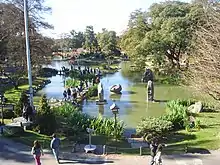Japanese Argentines
Japanese Argentines or Japanese Argentinians (Spanish: nipo-argentinos; Japanese: 日系アルゼンチン人, Nikkei Aruzenchin-jin), are Argentine citizens of Japanese ancestry, comprising Japanese immigrants and their descendants born in Argentina. Japanese migration to Argentina began in 1908 with the arrival of immigrants from Okinawa and Kagoshima.[1] The first Japanese entered the country via Brazil and succeeding groups of immigrants tended to reach Argentina through the neighboring nations. In the pre-war years, Japanese Argentines were concentrated in urban small businesses, especially dry cleaning and cafes in Buenos Aires (see es: Café El Japonés), while some worked as domestic servants, factory workers and longshoremen. A minority of Japanese Argentines also engaged in horticulture, floriculture and fishery. There is an important Japanese community in the city of Belén de Escobar where they settled and specialised in floriculture.
Nipo-argentino 日系アルゼンチン人 | |
|---|---|
| Total population | |
| 61,711 11,711 Japanese nationals 50,000 Argentines of Japanese descent | |
| Regions with significant populations | |
| Greater Buenos Aires, La Plata Partido, Escobar Partido, Misiones Province | |
| Languages | |
| Rioplatense Spanish · Japanese | |
| Religion | |
| Buddhism · Roman Catholicism · Shinto | |
| Related ethnic groups | |
| Japanese diaspora · Asian Argentines |
Between the 1960s and 1970s, more Japanese immigrants arrived in the country. Many were attracted by the economic opportunities in agriculture. According to the Ministry of Foreign Affairs there are 23,000 nikkei and 11,711 Japanese nationals in Argentina for a total of 34,711 people.
History
There were about 6,000 ethnic Japanese in Argentina in the late 1930s. The Argentine government was friendly with Japan up until the twilight of World War II, when pressure from the United States and the losses by the Axis Powers resulted in loss of diplomatic relations and the Argentine government declaring war against Japan and therefore causing Japanese institutions in the country to close. In the post-World War II period, most ethnic Japanese decided to stay in Argentina.[2] Additional immigration occurred around the 1950s.[3]
Culture

In regions with a substantial Japanese population in Buenos Aires, institutions such as Japanese associations and Japanese language schools were established by early Japanese immigrants.
During the United States-Japanese conflict of World War II, Argentina remained neutral until 1943, which limited the impact of war on the lives of Japanese Argentines. However, restrictions included the ban on meetings, Japanese education, newspaper publication, as well as a freeze on Japanese assets—which remained effective between 1944 and 1946.
Education

.JPG.webp)
There is a bilingual Spanish-Japanese private school, Instituto Privado Argentino-Japonés or Nichia Gakuin. The origins date from 1922.[4]
The Asociación Cultural y Educativa Japonesa/Colegio Japonés (ブエノスアイレス日本人学校, Buenosu Airesu Nihonjin Gakkō), an overseas school for Japanese national children, is located in Buenos Aires and has elementary and junior high school education.[5] It was established in 1961.[5]
Media
Prior to World War II, there were four Japanese newspapers in Argentina; the United States government influenced the Argentine government to close these publications in 1944.[2]
Notable individuals
- Mario Alberto Ishii, politician and mayor of José C. Paz
- María Kodama, writer with a Japanese father
- Jessica Michibata, model active in Japan
- Sonoya Mizuno, actress
- María Eugenia Suárez, actress
- Alicia Terada, politician and congresswoman
- Laura Russo, politician and congresswoman
See also
- South America Hongwanji Mission
- Asian Latin Americans
- Japanese Brazilians
- Café El Japonés (Early japanese migrations to Argentina)
References
- "Migration Historical Overview - Argentina Archived 2011-10-02 at the Wayback Machine", Discover Nikkei, 12 September 2007.
- Masterson, Daniel M. and Sayaka Funada-Classen. The Japanese in Latin America. University of Illinois Press, 2004. ISBN 0252071441, 9780252071447. p. 146.
- Masterson, Daniel M. and Sayaka Funada-Classen. The Japanese in Latin America. University of Illinois Press, 2004. ISBN 0252071441, 9780252071447. p. 146-147.
- Nogués, Germinal. Buenos Aires, ciudad secreta (Obras Diversas). Penguin Random House Grupo Editorial Argentina, May 1, 2015. ISBN 950075231X, 9789500752312. Google Books PT263: "Misceláneas. En Yatay 261 se halla el único colegio japonés de Buenos Aires, cuyos orígenes se remontan a 1922 y opera como escuela bilingüe."
- "海外子女教育のご案内." Embassy of Japan in Argentina (在アルゼンチン日本国大使館 / Embajada del Japón en Argentina). Retrieved on January 21, 2017. "設立:1961年 所在地:LA PAMPA 3520, (1430) BUENOS AIRES "